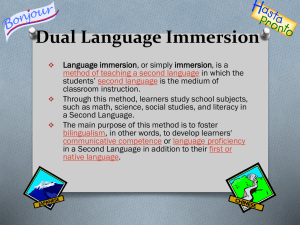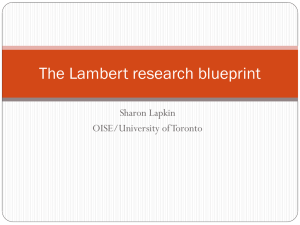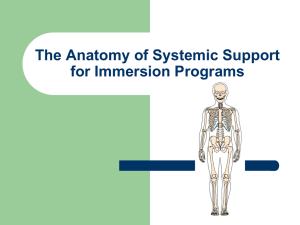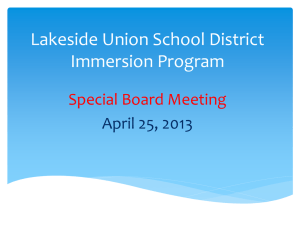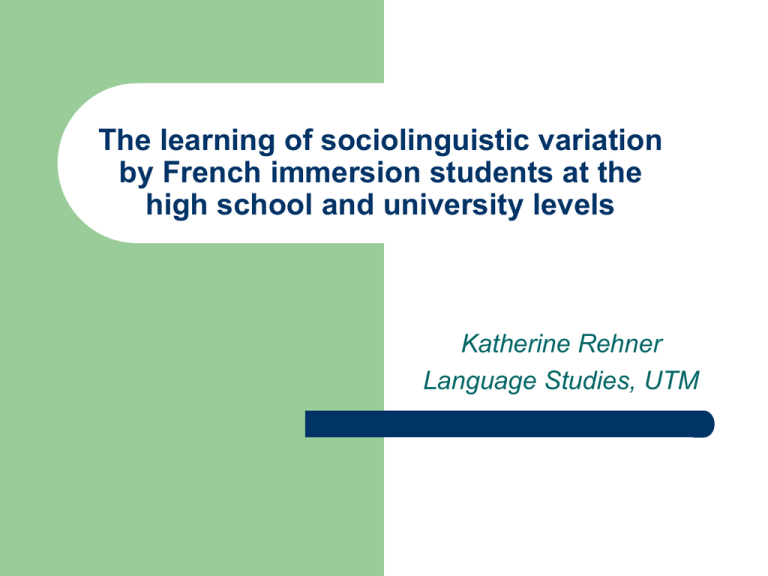
The learning of sociolinguistic variation
by French immersion students at the
high school and university levels
Katherine Rehner
Language Studies, UTM
Two lexical variables
Words referring to
remunerated work:
travail versus emploi
Verbs indicating one’s
place of residence:
habiter versus vivre
Previous Immersion Research
French immersion students:
–
–
–
–
over-use (hyper-)formal variants
under-use mildly-marked informal variants
dramatically under-use marked informal variants
the use of neutral variants depended on:
the availability of an English equivalent
the structural complexity of the variants
the frequency of the variants in the educational input
Lexical Variation: Montreal L1
Work Variable:
–
–
–
–
–
To Dwell Variable:
travail 35%
job 29%
ouvrage 14%
emploi 14%
poste 8%
–
–
–
–
Ouvrage/job = working class
Emploi/poste = upper class
Travail = socially neutral
rester 64%
demeurer 20%
vivre 10%
habiter 6%
Habiter = professional class
Demeurer = high-style form
Rester = working class
Vivre = neutral
Lexical Variation: Ontario L1
To Dwell Variable:
–
–
–
–
rester 42%
demeurer 32%
vivre 26%
habiter 1%
important role of lexical priming, especially for vivre
Lexical Variation: Immersion Students
Work Variable:
–
–
–
–
–
To Dwell Variable:
travail 56%
emploi 38%
job 6%
ouvrage 0%
poste 0%
Importance of lexical
priming
–
–
–
–
habiter 60%
vivre 40%
rester 0%
demeurer 0%
Highly important role for
lexical priming
Lexical Variation: Montreal L2
Work Variable:
–
–
–
–
–
travail 40%
emploi 34%
job 14%
poste 12%
ouvrage 0%
To Dwell Variable:
–
–
–
–
habiter 45%
rester 27%
vivre 25%
demeurer 1%
Research Questions
How do the Ontario university learners from former immersion
programs compare to the patterns of use of the ‘work’ and ‘to
dwell’ variables documented in the speech of the Ontario high
school French immersion students, the Montreal Anglophones,
and the native speakers of Canadian French from Montreal?
How do they compare to the patterns displayed for these
variables by their former core French counterparts enrolled in
FSL studies at the same university?
Do the results of these comparisons change depending on
whether we are dealing with variants that are socially stratified
or neutral?
Table 1
Characteristics of the Student Sample
ExtraLinguistic
Factors
1st Year
Core
(n) %
1st Year
Immersion
(n) %
4th Year
Core
(n) %
4th Year
Immersion
(n) %
TOTAL
(n) %
Sex
-female
-male
(19) 91
(2) 9
(16) 84
(3) 16
(8) 100
(0) 0
(12) 92
(1) 8
(55) 90
(6) 10
L1
-English
-Romance
-Other
(15) 71
(0) 0
(6) 29
(14) 74
(1) 5
(4) 21
(4) 50
(3) 38
(1) 22
(12) 92
(0) 0
(1) 8
(45) 73
(4) 7
(12) 20
Elementary
school†
-English
-French
-Mixed
(21) 100
(0) 0
(0) 0
(16) 88
(1) 6
(1) 6
(8) 100
(0) 0
(0) 0
(11) 85
(2) 15
(0) 0
(56) 91
(3) 7
(1) 2
High
school
-English
-French
-Mixed
(21) 100
(0) 0
(0) 0
(19) 100
(0) 0
(0) 0
(8) 100
(0) 0
(0) 0
(12) 92
(1) 8
(0) 0
(60) 98
(1) 2
(0) 0
Fr.environ.
-no time
-2 weeks
-semester +
(13) 62
(7) 33
(1) 5
(16) 84
(2) 10
(1) 6
(3) 38
(5) 62
(0) 0
(9) 69
(1) 8
(3) 23
(41) 67
(15) 25
(5) 8
TOTAL
(21) 35
(19) 31
(8) 13
(13) 21
(61) 100
†One
1st year former immersion student did not indicate an elementary school language
Table 2 Interview Length by Corpus
CORPUS
INTERVIEW
LENGTH
1st year
Core
4th year
Core
2300 words
High school
Immersion
1st year
Immersion
3400 words
4th year
Immersion
4700 words
3200 words
3500 words
Methodology
Data Collection:
–
–
–
61 students
Labovian-style interview
language background questionnaire
Data Analysis:
–
–
–
tokens identified using concordancer
coded for lexical priming
chi square test of independence
Hypotheses
Neutral variants:
–
relatively stable levels of use across cohorts
Figure 1 Use of ‘Less Formal’
Variants
100
90
80
70
60
50
40
30
20
10
0
Ne
c)
n
se)
us)
o
u
o
sd
sn
( vs
v
v
(
(
e
n
rs
us
O
o
l
n
A
no
L1 Speakers
University Immersion
High School Immersion
University Core
Hypotheses
Former immersion students making greatest
use of less-formal variants
Former core students on par with or lower
than immersion students when social
stratification between variants is marked
4th year university students making greater
use of less-formal variants than 1st year
counterparts
Figure 2 Results for work variable
50
45
40
35
travail
30
emploi
25
job
20
poste
15
10
5
0
ouvrage
Figure 3 Results for travail
70
60
50
Montreal L1
Montreal L2
University Immersion
High School Immersion
University Core
40
30
20
10
0
Travail (vs emploi)
Figure 4 Results for to dwell variable
80
70
60
50
40
30
20
10
0
habiter
vivre
rester
demeurer
Figure 5 Results for vivre
70
60
50
L1 Speakers
University Immersion
40
30
High School Immersion
University Core
20
10
0
Vivre (vs habiter)
Figure 6 Results for vivre by year
of study
70
L1 Speakers
60
50
4th University
Immersion
40
1st University
Immersion
30
High School Immersion
20
4th University Core
10
1st University Core
0
Vivre (vs habiter)
Figure 7 Results for habiter vs
vivre vs rester by cohort
90
L1 Speakers
80
70
4th University
Immersion
60
1st University
Immersion
50
40
High School Immersion
30
20
4th University Core
10
1st University Core
0
Habiter
Vivre
Rester
Figure 8 Use of vivre as a result of
lexical priming
100
90
80
70
60
50
40
30
20
10
4th Immersion
1st Immersion
4th Core
1st Core
0
Primed by Vivre
Primed by Habiter
Conclusions
The type of learning undertaken in the early years of
L2 studies sets learners up on differential footing
when they arrive at the university level and that
these differential footings are maintained throughout
the learners’ university studies.
Any advantage afforded by the type of naturalistic
learning offered in immersion programs does not
transfer into a beneficial effect for the learning sociostylistically neutral variants.
Implications
Former immersion students are at an advantage over their
former core French counterparts.
The type of naturalistic learning undertaken in an immersion
program provides students with a better grasp of ‘natural’
language.
This conclusion is supported by the advantages over their 1st
year counterparts displayed by the 4th year former core French
students who have had the opportunity to study in French as a
medium of communication.
References
Mougeon, F., & Rehner, K. (2008). Identity and nativelikeness in bilingual FSL learners. In P. Collier (Ed.)
Modern French Identities. Cambridge: Peter Lang.
Mougeon, F., & Rehner, K. (in press). From grade school to university: The variable use of on/nous by
university FSL students. Canadian Modern Language Review.
Mougeon, R. & Beniak, E. (1991). Linguistic Consequences of Language Contact and Restriction: The
Case of French in Ontario. Oxford: Oxford University Press.
Mougeon, R., Nadasdi, T. & Rehner, K. (2002). État de la recherche sur l’appropriation de la variation par
les apprenants avancés du FL2 ou FLE. Acquisition et Interaction en Langue Étrangère 17, 7-50.
Mougeon, R., Rehner, K., & Nadasdi, T. (2004). The learning of spoken French variation by Immersion
students from Toronto, Canada. In R. Bayley and V. Regan (Eds.) Journal of Sociolinguistics: Special
Issue, 8, (3), 408-432.
Nadasdi, T. & McKinnie, M. (2003). Living and working in immersion French. Journal of French Language
Studies 13, (1), 47-61.
Rehner, K., (in press). The use/non-use of ne in the spoken French of university-level FSL learners in the
Canadian context. Journal of French Language Studies.
Rehner, K., & Beaulieu, N. (2008). The use of expressions of consequence by core and immersion French
graduates in a bilingual university setting. Mosaic: The Journal for Language Teachers, 10 (2), 13-19.
Rehner, K. & Mougeon, R. (2003). The effect of educational input on the development of sociolinguistic
competence by French immersion students: The case of expressions of consequence in spoken French.
Journal of Educational Thought 37, (3), 259-281.


